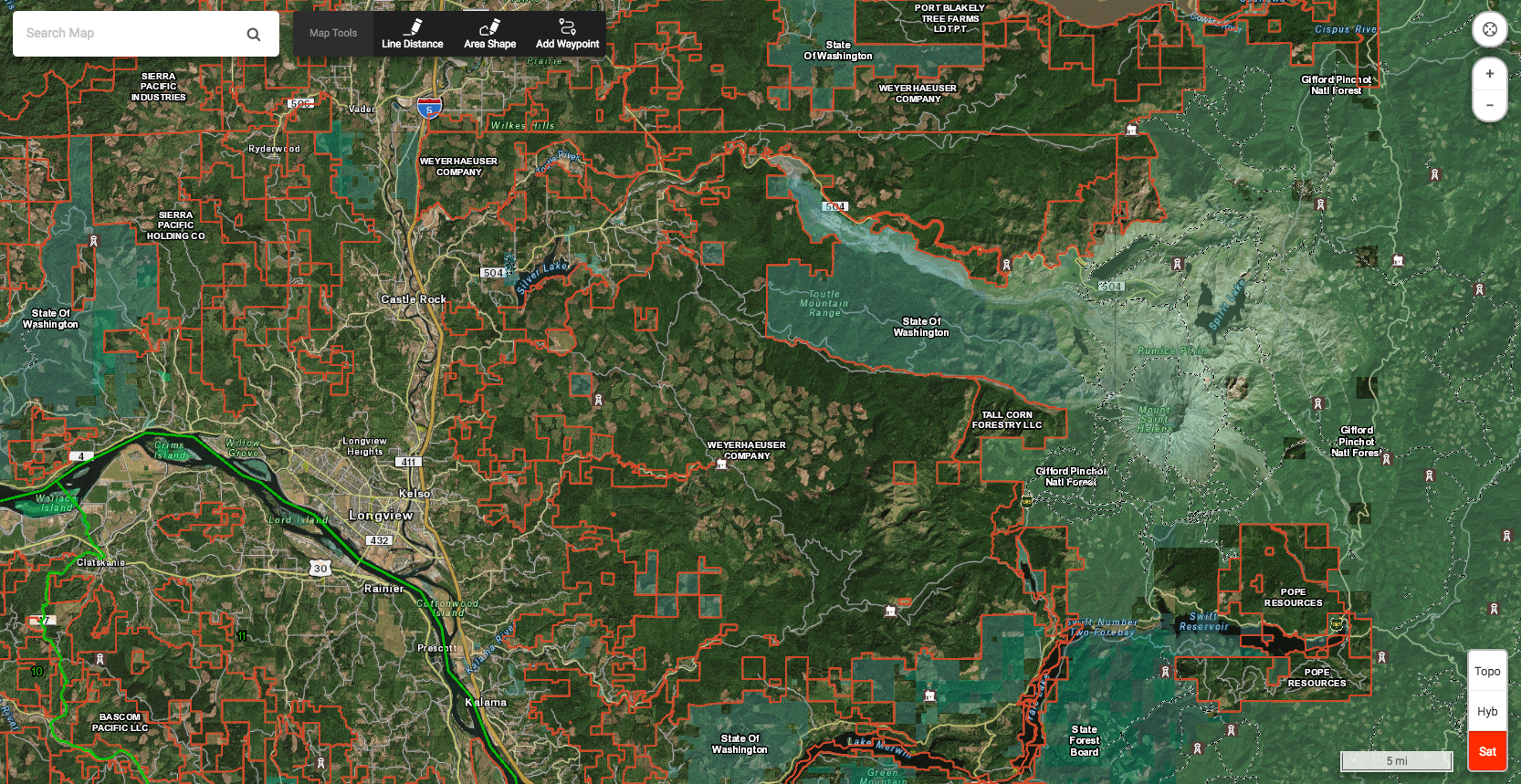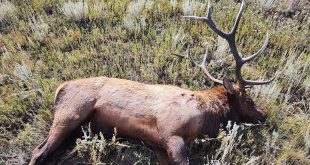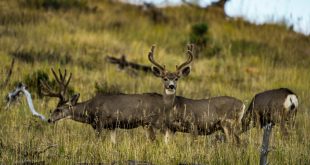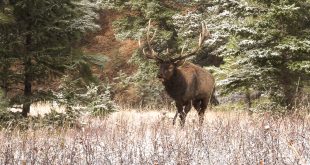
Elk hoof disease showed up in southwestern Washington elk herds around 2000 and has been slowly progressing ever since. A dramatic rise in reports of limping elk in 2007 prompted a scientific investigation into what was causing the rapid spread. Symptoms include limping while walking and overgrown or broken hooves. It is also reported that bull elk have deformities of the opposite antler, depending on the timing of the hoof infection. Washington Department of Fish and Wildlife (WDFW) scientists still don’t understand what causes the disease or how it spreads. The bacteria they have found to be present is a Treponema variety which is causing damage to the affected hooves. However, the WDFW team claims that Treponema is not the root cause of the hoof disease.
“I also have a little bit of concern because the Treponema hypothesis still requires an initiating event…until you figure out what that triggering event was you’re not going to be able to really understand the disease,” said Dr. Fairbrother, an ecotoxicologist with Exponent Engineering and Scientific Consulting.
Governor Jay Inslee has called upon Washington State University (WSU) to monitor the elk and continue studying them. They are just waiting on the legislature to determine where the funding of the project will come from. Charlie Powell, the PR officer for WSU’s College of Veterinary Medicine, said that although they have done some analysis of samples from 2009-2013 they still cannot find the catalyst for what is causing the disease. Now hoof rot is showing up in Oregon elk as well, so it is a never-ending problem.
Gene Crocker of Washington, a 20 year veteran of Cowlitz County Game and Anglers claims it’s simple. “I found out that after Weyerhaeuser clear cuts an area, they spray it with herbicide,” Crocker said. “This kills broadleaf plants for 3-5 years.” He also claims that the scientists don’t know what they’re talking about. “They haven’t been here like I have for 78 years and seen how things have changed. Deer run around with hair loss, pigeons have disappeared completely. We have few grouse now. Honeybees have ceased to exist in the wild.”
 Mark Smith, owner and builder of Eco Park resort near Mt. St Helens has also witnessed the decimation of the area’s elk and deer population. “Ninety percent of all the chemicals that Weyerhaeuser uses say ‘DON’T USE ON GRAZING LAND’,” Smith said…”Why do we allow forest land to be sprayed when deer and elk graze in these areas?”
Mark Smith, owner and builder of Eco Park resort near Mt. St Helens has also witnessed the decimation of the area’s elk and deer population. “Ninety percent of all the chemicals that Weyerhaeuser uses say ‘DON’T USE ON GRAZING LAND’,” Smith said…”Why do we allow forest land to be sprayed when deer and elk graze in these areas?”
Mt. Pleasant resident Krystal Davies is a farrier and hoof specialist that has been studying hooves for over a decade. “I do believe that I understand why the elk in Washington are being affected by this hoof disease. I do have scientific-based evidence that can provide a plausible diagnosis, a source of the disease, a detailed route and manifestation of the pathogen, as well as a potential cure.” Davies goes on to say, “It is my belief that there are several factors to this situation but that herbicides and pesticides are the root cause.”
Herbicides are also known to reduce immune system strength, enabling bacteria to take advantage of severely weakened animals. One of the common chemicals used by timber companies is Atrazine, and according to the National Toxicology Program, Atrazine is an immunotoxin and disrupts the function of the immune system by as much as 70%.
Upon further investigation into the aerial spraying program, Weyerhaeuser began a spraying regimen beginning in 2006 that consists of five different chemicals on clear cuts after they are logged. Chemicals like Atrazine, Clopyralid, Hexazinone, and Indaziflam are a part of that regimen. You might know them as Roundup, Crosshair, Rodeo, Transline, and Velpar. These chemicals keep brush at bay, such as Alder, Scotch broom, and blackberry so it doesn’t compete with the planted Douglas fir seedlings. Remember that 2007 was the year that reports of hoof rot cases blasted through the roof!
Leptospirosis is also another concern. Dr. Boone Mora claims that Leptospirosis is everywhere in southwest Washington. In fact it is everywhere, it is the world’s most common zoonosis. It is known by the WDFW that the bacteria have been widespread in the elk population since the early 90s. Dr. Mora has studied leptospirosis his whole life as county health director in North Carolina and wants to help. He believes this bacteria is most definitely part of the equation. The symptoms are severe pain in the lower extremities, which could explain limping elk. Wildlife regional manager Sandra Jonker said, “There is no evidence of an association between leptospirosis and hoof disease in any of the elk that have been examined. Dr. Mora also claims that history shows leptospirosis is often misdiagnosed because it is so similar to other bacteria. He goes on to say that he wants to help but, WDFW officials “won’t cooperate with me in any way, they are very unethical in my opinion and they suppress information.”
Wildlife officials insist there is no correlation to the heavy herbicides and hoof rot. Here we are 25 years later and there are still no answers. Elk keep suffering and dying. WDFW has reported there has been a 35% decline in the Mount St. Helens herd over the past 5 years. Hunters in SW Washington complain there are hardly any elk to hunt anymore. More studies are to be done, and we can only hope a solution will be found before it’s too late. In 2017, the state legislature passed a bill shifting authority of hoof rot research to WSU. In 2018 the Washington legislature allocated $3M to WSU for 2 years’ worth of work to study hoof disease. WDFW has allocated $480,000 to hoof disease efforts in the past two years as well.

The above photo shows all observations of limping or dead elk during the length of the disease’s existence in the Mount St. Helens herd.

Cross-reference this land ownership map and notice the concentrations of reports on timber company land. The Forest Service made clear cut spraying illegal in 1984.
Sources
Citizens Express Profound Distrust of Fish and Wildlife Officials, Herbicide Spraying and Safety of Elk Meat. (2017, October 25). Retrieved from http://jongosch.com/citizens-express-profound-distrust-of-fish-and-wildlife-officials-herbicide-spraying-and-safety-of-elk-meat/
Lobet, I. (2012, August 15). In Oregon, Residents Struggle to Solve a Pesticide Mystery. Retrieved from https://www.theatlantic.com/national/archive/2012/08/in-oregon-residents-struggle-to-solve-a-pesticide-mystery/261083/
Growing Evidence Links Herbicides to Elk Hoof Disease. (2017, October 25). Retrieved from http://jongosch.com/growing-evidence-links-herbicides-to-elk-hoof-disease/
Landers, R. (2018, January 10). Elk hoof disease research hit high gear in Oregon, Washington. Retrieved from https://www.statesmanjournal.com/story/travel/outdoors/2018/01/09/elk-hoof-disease-research-hit-high-gear-oregon-washington/1013694001/
Citizens Express Profound Distrust of Fish and Wildlife Officials, Herbicide Spraying and Safety of Elk Meat. (2017, October 25). Retrieved from http://jongosch.com/citizens-express-profound-distrust-of-fish-and-wildlife-officials-herbicide-spraying-and-safety-of-elk-meat/
 Eastmans' Official Blog | Mule Deer, Antelope, Elk Hunting and Bowhunting Magazine | Eastmans' Hunting Journals
Eastmans' Official Blog | Mule Deer, Antelope, Elk Hunting and Bowhunting Magazine | Eastmans' Hunting Journals





Hi there
Living here in the northwest and working around the elk everyday I believe one of the big issues not being looked at is the elk do not migrate anymore. They stay down in the soft bottom land as there is no hunting pressure and green fields. This is not normal for elk or for the hoofs to be in this kind of bottom land. If you place horses in these fields there hoofs rot off as well.
We need to have pressure on these elk to migrate up into the high country with the shale and dry ground and out of the fertilized fields. The more generations of elk that stay they will loose the ability and knowledge to migrate…. Try and find a elk in the Packwood unit….. You can’t as the elk stay down low in the fields and in town….
The previous commenter is exactly right. But I also think we need to look at the issue of grain. In our area, we noticed the problem really started after it became legal to put out grain for the elk. Several of our neighbors have feeding stations. The elk have created a highway through our hayfields to get from one neighbors grain to the other. Be raise cattle and goats, and are well aware of the relationship between grain and hoof problems. But no one is talking about that with the elk. How come?
Monsanto anyone????? I didnt make it 3 sentences into the story and I thought of aerial spraying of herbicides as the cuplrit. Where to we see the most DLH syndrome lands? Near bottomlands, croplands and pvt timber lands where herbicides and fertilizers are being used. I also agree with Mike. Elk,, Rosies in particular are generally non migratory, stay in wetter areas and areas that are low pressure as to not require much migration if at all.
They eat and walk in clear cuts that are with sprayed with HERBICIDES from the logging companies. It turns these units brown and kills everything at first. They don’t burn any more. Blacktail deer population is down also.???
A few points that the author missed. First, hoof disease was initially discovered around 1988, not 2000. The WDFW ignored the threat until public outcry in the early 2000s became impossible to ignore. Secondly, the first “scientist” quoted, Dr. Fairbrother, is a professional witness for the herbicide industry in liability cases against herbicide manufacturers, most especially Syngenta which manufactures Atrazine (another harmful herbicide which has been linked to amphibian declines where the chemical is used on midwest crops). Having Dr. Fairbrother on the panel is a direct conflict of interest. Timber companies which employ Exponent Engineering and Scientific Consulting, her employer, donate heavily to politicians on both sides of the aisle, ensuring that the use of herbicides on clearcuts will not be considered as a root cause of hoof disease, leaving timber companies free to continue unabated spraying of dangerous chemicals. Admittedly, intrusive EPA regulations against slash burning have left timber companies with few other alternatives for clearing undergrowth from clearcuts. Next, glaringly absent from the list of chemicals used is glyphosate, A.K.A. RoundUp. Lastly, Dr. Boone Mora not only worked in NC, but worldwide with the CDC out of Atlanta as an expert on the effects and treatment of leptospirosis. He has offered his expertise free of charge to the WDFW to study infected elk on his farm and was ignored. It is somewhat hopeful that WSU has now taken the lead on the study. But while political interests continue to influence the panel, it is doubtful that a fair and comprehensive assessment of the disease will take place. To date, the WDFW’s solution to this crisis is to support the original hypothesis and kill affected elk. We are not being told the truth about this horrible disease.
This is a classic example of journalism playing fast and loose with science. Please do not read a chemical warning label and assume that the herbicides are being applied recklessly or in toxic doses. I’ve been a silviculture forester for over 20 years. The herbicide mixes that are sprayed in forest plantations are highly regulated, virtually non-toxic, and applied once every 40 years. The compounds used today are far more benign than those used in the 60s and 70s. The same elk are grazing ag fields that are treated multiple times every year with actual toxic compounds (including manure).
If Forest herbicides were the issue, the disease would be much more prevalent in Oregon, where, for 25 years, forest chemical use has been more intense and frequent.
We will not find a solution to this problem if this witch hunt keeps derailing the research.
Mike… First, your belief in the accurate measured application of herbicides by timber companies is miss-placed at best (I am being kind). Second, No state or federal officer or scientist observes or measures the concentrations of these sprays when mixed or when being applied, nor are any inspectors in the field when applied. The application of herbicides is regulated and controlled solely by the timber companies. No one actually knows how much or how little is applied on any given application… this process is regulated on paper – only.
Hi Neal
You opinion is not unique. There are many people who believe that silviculture is an archaic science. Rather than argue about this online, I will offer to you what I have to many other skeptics. I invite you to join me in the field to witness an actual forest herbicide application. You will be surprised and relieved to see the precision and professionalism of the crew, and the level of protection measures that are in place for critical habitats, water, and wildlife. In addition, our work is frequently audited to maintain our certification. We also have deer and elk feed test plots that clearly show the interaction between herbicide control of weeds and food distribution on the landscape. If you are interested in real data, please reach out to the blog administrator who has my email. Mike
Are you working on a pension plan from Weyco Mike???
I have seen an actual forest herbicide application in person. While sitting on a clear cut next to my truck in wheyerhuaesers south Pe Ell unit a helicopter flew over the ridge and sprayed me and my son. I do not see that as being professional Mike. I have also seen the deer population dramatically decrease in the area since the sprays have began. Those who knowingly poison animals should be in prison.
Ya know what’s funny? SW Washington has had hoof rot problems since the 80’s! We rarely observed it until Weyerhauser took over Fibre property in NW Oregon. Now each year it is worsening, at a pace I never thought was possible. I guess my question is, what would it hurt to discontinue spraying for a period of time to see if the condition improves? Otherwise wildlife is suffering while the powers to be are hung up in litigation. It’s tough to watch man destroy earth due to simple greed…Weyco
Exactly! Fact! Over kay elk hoof rot cases with Weyco property map! Bingo! U dont find too many cases on state or fed lands or even other timber company lands